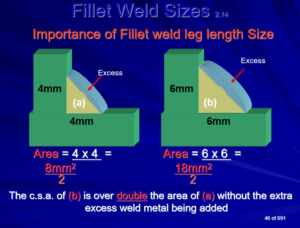Welding is a critical process in industrial fabrication, pipeline maintenance, pressure vessels, and structural applications. As a qualified welding inspector (CWI/API 570/ASME Certified), I understand the importance of precision welding, adherence to safety protocols, and compliance with industry standards such as AWS D1.1, API 1104, and ASME Section IX.
In this guide, we will cover the best welding techniques, safety measures, and quality control practices to ensure defect-free welds with high structural integrity.


For Comprehensive Detail ; See Presentation:
1. Key Welding Techniques & Their Industrial Applications:
Each welding process is designed for specific materials, environmental conditions, and industry applications. Choosing the correct method is crucial for achieving high-strength welds with optimal mechanical properties.
1.1. Shielded Metal Arc Welding (SMAW / Stick Welding)
✅ Best for: Pipeline construction, structural steel, offshore applications.
✅ Advantages: Works well in outdoor environments and on dirty/rusty materials.
✅ Limitations: Requires skilled operators to control slag inclusions and arc stability.
1.2. Gas Metal Arc Welding (GMAW / MIG Welding)
✅ Best for: Stainless steel fabrication, automotive industry, pressure vessel welding.
✅ Advantages: High deposition rate, minimal slag, good for thin to medium materials.
✅ Limitations: Requires shielding gas, making it less suitable for outdoor applications.
1.3. Gas Tungsten Arc Welding (GTAW / TIG Welding)
✅ Best for: Precision welding in aerospace, nuclear, and medical industries.
✅ Advantages: Produces the highest-quality welds with minimal defects.
✅ Limitations: Slower process, requires high operator skill level.
1.4. Flux-Cored Arc Welding (FCAW)
✅ Best for: Heavy fabrication, shipbuilding, and high-production welding.
✅ Advantages: High penetration, excellent for thick materials.
✅ Limitations: Can produce slag inclusions if not properly controlled.
2. Welding Safety: Preventing Hazards & Ensuring Compliance:
Welding involves extreme heat, hazardous fumes, and potential electrical shocks, making safety compliance non-negotiable. Below are key safety measures for welders, welding inspectors, and supervisors.
2.1. Personal Protective Equipment (PPE) Requirements
🔹 Auto-darkening welding helmets (ANSI Z87.1 compliant) to protect from UV/IR radiation.
🔹 Fire-resistant gloves, jackets, and aprons to prevent burns.
🔹 Respiratory protection (PAPR systems) for fume extraction in confined spaces.
2.2. Ventilation & Fume Extraction
🔸 Use local exhaust ventilation (LEV) to reduce exposure to welding fumes.
🔸 Conduct air monitoring to ensure compliance with OSHA/NIOSH exposure limits.
🔸 Avoid welding in confined spaces without proper gas detection and permits.
2.3. Electrical & Fire Safety
🔹 Inspect welding leads and electrode holders before use.
🔹 Maintain a 5-meter fire-free zone and keep fire extinguishers accessible.
🔹 Implement hot work permits in compliance with NFPA 51B.
3. Quality Control & Welding Inspection Standards:
As per AWS, API, and ASME standards, welding inspections ensure compliance with design requirements and prevent catastrophic failures.
3.1. Welding Procedure Qualification (WPS/PQR)
✅ Ensure Welding Procedure Specifications (WPS) are qualified per ASME Section IX or API 1104.
✅ Conduct Procedure Qualification Records (PQRs) for new materials and applications.
3.2. Welder Qualification & Certification
✅ Verify that welders are certified per AWS D1.1, ASME IX, or API 1104.
✅ Ensure continuity records are maintained to track welder performance.
3.3. Non-Destructive Testing (NDT) for Weld Quality Assurance
🔹 Visual Inspection (VT): First line of defense against welding defects.
🔹 Radiographic Testing (RT): Ideal for detecting internal flaws (porosity, cracks).
🔹 Ultrasonic Testing (UT): Used for volumetric defect detection in pipelines.
🔹 Magnetic Particle Testing (MT): Effective for surface and near-surface cracks.
🔹 Penetrant Testing (PT): Best for non-ferrous metals and aerospace applications.
4. Common Welding Defects & How to Prevent Them:
Defects compromise weld integrity, leading to failures in pipelines, pressure vessels, and structural steel. Below are the most critical defects and their prevention strategies:
| Welding Defect | Cause | Prevention |
|---|---|---|
| Porosity | Trapped gas due to contamination | Clean surfaces, use correct shielding gas |
| Lack of Fusion | Incorrect heat input or travel speed | Adjust voltage, ensure proper penetration |
| Cracks | Rapid cooling, poor preheat control | Use proper preheat/post-weld heat treatment |
| Undercut | High voltage, improper electrode angle | Reduce voltage, correct travel speed |
| Slag Inclusion | Poor slag removal, incorrect electrode manipulation | Use proper electrode technique, grind between passes |
Final Thoughts: Enhancing Welding Productivity & Safety:
Optimizing welding techniques, safety measures, and quality control processes is essential for achieving defect-free welds in industrial applications. By following AWS, API, and ASME guidelines, companies can ensure compliance, safety, and efficiency.
✅ Key Takeaways:
✔ Choose the right welding technique based on application and material.
✔ Implement strict welding safety protocols to prevent hazards.
✔ Follow NDT & welding inspection standards to maintain weld integrity.
✔ Continuously train welders and update WPS/PQR records.
For professional welding consultation or compliance guidance, feel free to connect!
